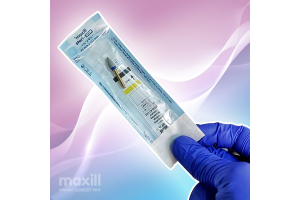Air Changes per Hour and Fallow Times Based on Geographical Regions

Air quality has surfaced as a hot topic in the pandemic control measures for dental offices.
Air quality falls under Additional Precautions in a dental office's IPAC Program.
Pre-pandemic, offices were following Routine Practices covering hand hygiene, sharps safety, risk management, and personal protective equipment.
Additional precautions are just that, an addition to the routine practice.
Additional precautions are required during respiratory viral outbreaks such as SARS-COV-19.
Dental services are now categorized as either aerosol gas producing (AGP) or non-aerosol gas producing (NAGP) with each having its own lineup of PPE.
Aerosols have always been a known subject in dentistry.
Up until now, however, not every dental office was performing a risk assessment to determine the type of PPE required for the treatment being rendered.
Along with PPE selection is also the consideration of accounting for the air changes per hour (ACH) and determining a fallow time.
Although it’s one of the main topics of conversation, it is not equally distributed as a guideline or standard in Canada.
What does each of the provinces do?
Provinces and territories vary vastly on the topic of the measurement of ACH and the application of the value to a fallow time.
Depending on the location of the office, the guidelines/standards may involve the office scheduling an HVAC technician to test each operatories ACH or not.
Depending on the location of the office, a fallow time may be required or not.
The Centre for Disease Control offers Table B.1.
Air changes/hour (ACH) and time required for airborne-contaminant removal by efficiency to guide dental offices in determining the wait time between clients.
It should be noted that fallow times are for the protection of both the clinician and the client.
Dental offices that require to observe a fallow time would be wise to be transparent with their clients and share this information.
Most offices will have this stated as a risk disclosure along with the client screening.
Clients start asking, and that's okay
In the sense of the obvious, clients may be asking why the office décor has changed to an industrial look with plastic walls and zipper doors.
This is a positive conversation and the type of communication that builds rapport, and trust and lets the public know dental offices have taken their safety seriously.
As with many other systems and areas of the dental practice, safeguarding your practice with proper documentation and record-keeping is also part of ACH and fallow times.
If an HVAC test is required, ensure to obtain a copy of the results from the HVAC technician.
Most reports have the number of each operatory and the HVAC test performed as a count in ACH for the operatory ‘as is’ and another column for the operatory with the addition of a HEPA filter at whatever units of filtration.
The HVAC testing company sells HEPA filters and will be happy to assist you in pairing the type and size of unit required to improve the ACH and decrease your fallow times.
ACH and fallow times are directly dependent on one another, the better the ACH the lower the fallow time (less time waiting between clients).
So, if your geographical area is one that requires attention to ACH and fallow times, it would be foolish to not perform an ACH test as you may be surprised and have high ACH that requires very low fallow times.
Retain a digital copy of the HVAC report with most regulatory bodies stating a retention of 10 years.
Add an appendix
As many changes unfold in dental practice, on the topic of record-keeping, the office's IPAC manual will need to reflect air quality, allocating an appendix for the HVAC report and how the office determined the fallow times.
This is an opportunity to assess what level of IPAC manual your office has.
Many offices have made a good attempt at placing supportive resources in a digital file and/or binder.
However, this is NOT an IPAC manual, this is an appendix.
An IPAC manual must have a complete table of contents and be specific and tailored to the office's policies and procedures reflective of the office's exact equipment, products, staff, number of operatories, type of dental services, etc.
In 2019, maxill expanded its services to include a product called IPAC 360, an IPAC manual completely tailored to YOUR practice.
I personally researched and brought the service to maxill inc, having written countless practice management policies and procedures and instructing on the topic at Fanshawe College.
Writing an IPAC manual is no simple task but it needs to be done.
Quality help is here for YOUR IPAC manual.
Conclusion
For the reasons of inconsistency in ACH and fallow times, I end this article with an adaptation from Public Health Ontario’s document Covid-19 Dental Care Settings with the table below that summarizes and compares data per province/territory and offers the direct link to the regulatory bodies document for additional reading.
The overall purpose of the article is to make the dental professionals' pandemic journey somewhat easier with the adaptation to the new ‘norm’ of practice management and clinical care.
As every dental office is busy catching up on a backlog of client treatment, maxill hopes this summary saves you time and energy in getting the facts and resources on ACH and fallow times for YOUR area.
Stay safe.
Province or Territory |
Regulatory Body |
Fallow Time |
Notes |
|---|---|---|---|
| Alberta | Alberta Dental Association and College | No fallow time requirements | Guidance discusses the clearing of aerosols but does not make recommendations. Alberta’s healthcare guidance states: “No settling time is required after AGP is complete.” |
| British Columbia | College of Dental Hygienists of British Columbia (BC), College of Dental Technicians of BC, College of Denturists of BC, College of Dental Surgeons of BC | No fallow time requirements | Recommendations for increasing ACH and ventilation in patient areas. Appropriate PPE for AGPs. No mention of fallow times post AGPs. States increased relative humidity and high ACH will reduce the potential for bioaerosol spread by over 95% within 10-12 minutes following AGP. |
| Manitoba | Manitoba Dental Association | No fallow time requirements | Emphasis on aerosol reduction at source. The provincial healthcare guidance on AGPs recommends 99.9% contaminant removal. |
| Newfoundland & Labrador | Newfoundland & Labrador Dental Association, Newfoundland & Labrador Dental Board | No fallow times | Discusses aerosol clearance and various factors to impact air quality. Due to many factors impacting air quality, the advisement is to seek professional assistance to assess. |
| Northwest Territories | Government of Northwest | Fallow time of 15 minutes for medium-risk procedures. High-risk procedures 120 mins. | 99% removal after high-risk procedures. Risk categorization is similar to Saskatchewan. After medium-risk AGP, fallow time is 15 minutes; after high-risk AGP, aim to remove 99.9% of contaminants. See the document for strict procedures on high-risk AGP. |
| Nova Scotia | Provincial Dental Board of Nova Scotia | No fallow times | No recommendations for observing fallow times based on air changes per hour for AGP. |
| Ontario | Public Health Ontario Royal College of Dental Surgeons of Ontario College of Dental Hygienists of Ontario |
Fallow time ranges from 15-30 mins | Emphasis on aerosol reduction at sources as well as recommends 99.9% airborne contaminant removal post-AGP. |
| Québec | Ordre des dentists du Québec | Fallow time based on the Air Changes per Hour test outcomes | Objective of 90% removal. Isolation protocol via a closed room for asymptomatic patients and suspected/confirmed COVID-19 patients; schedule and treat confirmed COVID-19 patients at end of the day. |
| Saskatchewan | Saskatchewan College of Dental Surgeons of Saskatchewan | 15 minutes for medium-risk procedures | 99% removal after high-risk procedures. Fallow period of 120 minutes in a closed operatory for high-risk procedures if air changes are unknown. Medium and high-risk procedures are defined as those with and without the use of a rubber dam. Non-aerosol manual procedures are considered low risk. The acute healthcare setting guidance recommends 99% contaminant removal after AGPs. |
Adapted from: Public Health Ontario COVID-19 in Dental Care Settings 07/08/2020







